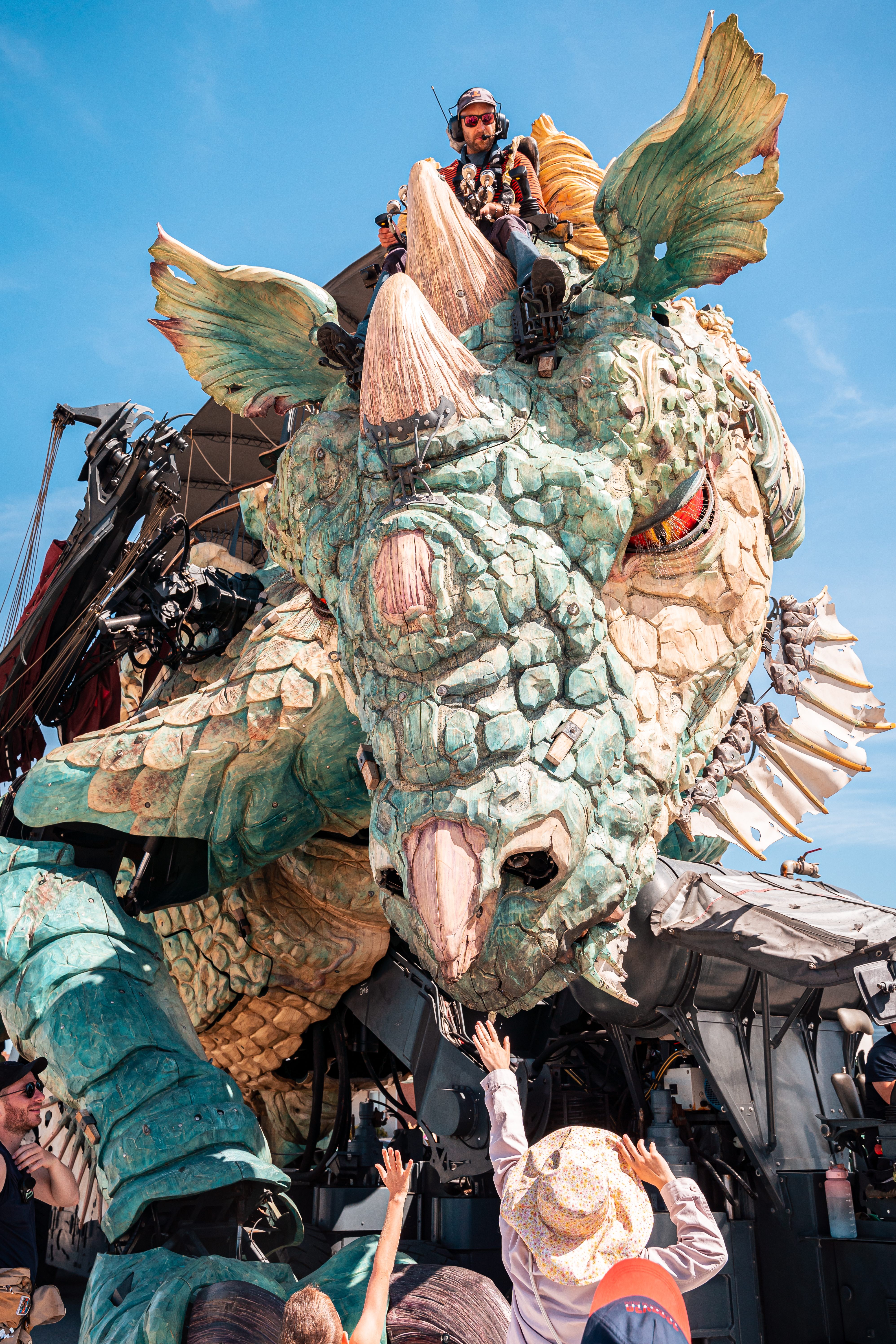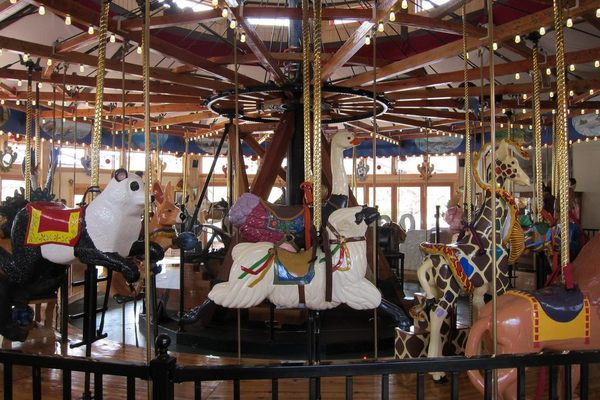How to Maintain Your Dragon
A massive, winged beast prowls Calais—thanks to a dedicated team of operators and “veterinarians.”
Not everyone knows that Calais, a trade and transit hub on the north coast of France, is also a portal to an underground world—at least, that is, according to a larger-than-life local’s PR team. This gateway opened during expansion work a few years ago at the Port of Calais, and released a huge and powerful dragon that now patrols the city’s shoreline. According to the dragon’s press, the fantastic beast is “naturally benevolent, but can also be wild and unpredictable.”
So goes the story of The Calais Dragon, created by François Delarozière, one of the artists behind the intricate puppet-automatons known as the Machines of the Isle of Nantes. Delarozière was commissioned by Natacha Bouchart, the mayor of Calais, to create a unique addition to the cityscape, a piece of public art that would incorporate elements of land, sea, and air, capturing the imagination of resident and visitor alike. And this is why, standing on the deck of a ferry as it arrives at the port city, you might spot people riding on the back of a 39-foot-tall, fire-breathing creature that’s creeping along the waterfront. Part sculpture, part machine, part puppet, the dragon has become a beloved piece of interactive street theater—but its charming ways require the devotion of an entire entourage.
Officially, Philippe Ryckeboer’s job title is pilot machinist, but, he says, “I prefer ‘dragon lord’.” Ryckeboer is one of eight machinists for the dragon; when it’s actively prowling the waterfront, a minimum of four of them are engaged. One machinist drives the chassis that supports the 79-ton-plus wood and metal structure, and another stands on the dragon’s back, operating the tail and wings. The pilot sits in and controls the head, while a guide machinist walks at ground level to operate the dragon’s facial expressions and provide support for the pilot, driver, and wingman. “Ask any one of the machinists what their favorite part is to operate and they all say ‘the head’,” says Stéphane Ribeiro Da Ascencao, the “Calais Dragon storyteller” (and official spokesperson). Ryckeboer agrees: “This is where you have power over the dragon and you get to have interaction with the people on the streets… And you go really high. It’s fun.”

The machinists work as a single unit to make the dragon’s movement both lifelike and safe—it is, after all, a fire-breathing behemoth moving through a crowded urban space.
Three “veterinarians” round out the team and are responsible for keeping the dragon in tip-top, fire-spitting shape. That includes daily feedings of “strawberry syrup” (red diesel) and close monitoring of its onboard computer, 48 batteries, countless pumps, valves, and yards of wiring. The dragon’s anatomy is “a unique recipe of parts,” says Ribeiro Da Ascencao—but fortunately, they’re mostly car parts that are available from any well-stocked auto parts store.
And when things do go wrong, as with any computer, the machinists turn it off and on again. Even dragons need the occasional reboot, apparently. The dragon only struts its stuff when everything is working properly, from its sail-sized wings to its eye blinks. “Being sleepy on the road is not happening,” says Ribeiro Da Ascencao. “Every single detail is important, it’s part of the theater.”
When it’s not out and about, the dragon retreats to its lair, a vast hangar with walls of see-through polycarbonate—but it’s not alone. Other winged locals seem to gravitate to it, blackbirds in particular. A nest in its mouth was removed for obvious, fire-breathing reasons, but another blackbird family, settled comfortably into the dragon’s neck, remains. “One day when I was on the head, I realized I could hear the birds singing. It was so cute,” says Ryckeboer. “The dragon is a protective animal, so even for little birds, it’s a great home.”
Unfortunately for the dragon’s crew, the birds show little respect for their guardian: Most mornings start with cleaning prodigious amounts of bird poop from the dragon’s back.

After the mess has been cleared, it’s time to wake the dragon—what Ryckeboer calls “the first adventure of the day.” The pilot climbs along its vertebrae to its head, with each pilot putting their own spin on the dragon’s personality for that shift, from slightly grumpy to gently playful. A curious child diverted from their ice cream to gaze up at the fascinating creature may find the beast takes a lick of their treat. A puzzled dog could receive a loud snort or light-hearted growl. The guide machinist on the ground acts as conductor for the rest of the team, to make sure they improvise and interact with their audience at each performance in a responsible way. Not everyone, after all, appreciates getting sprayed with dragon mist.
There’s a sense of whimsy to every aspect of the dragon, from its “strawberry syrup” diet to the job titles of the people who operate and maintain it. And, in true fairy-tale style, there is also sometimes a darker undercurrent. When children ask what the dragon eats, says Ribeiro Da Ascencao, “We usually answer ‘children who aren’t nice to people’.” (Of course, the dragon’s diet is more keto than kiddo: It’s able, says Ryckeboer, to fish at night, drink seawater, and nibble trees and vegetables. “Good health means good flames,” he adds.)
In fact, the dragon’s freedoms are reinforced in a set of municipal bylaws about how it coexists with the humans of Calais. For example, the dragon must not use the ferries crossing the English Channel as paddleboards and, following a swim, the dragon must not shake itself and risk triggering a flood. Local restaurants, meanwhile, must not use pepper; a dragon-sized sneeze could whip up a storm that hits the English coast some 25 miles away. Again, safety first.
For its part, properly fed and feted, the dragon serves as a guardian not to an underworld gateway but to rediscovering a kind of simple and wondrous delight often obscured by screens and other elements of modern life. “When conditions are just right,” Ryckeboer says, “The dragon’s spray can create rainbows.”



























Follow us on Twitter to get the latest on the world's hidden wonders.
Like us on Facebook to get the latest on the world's hidden wonders.
Follow us on Twitter Like us on Facebook